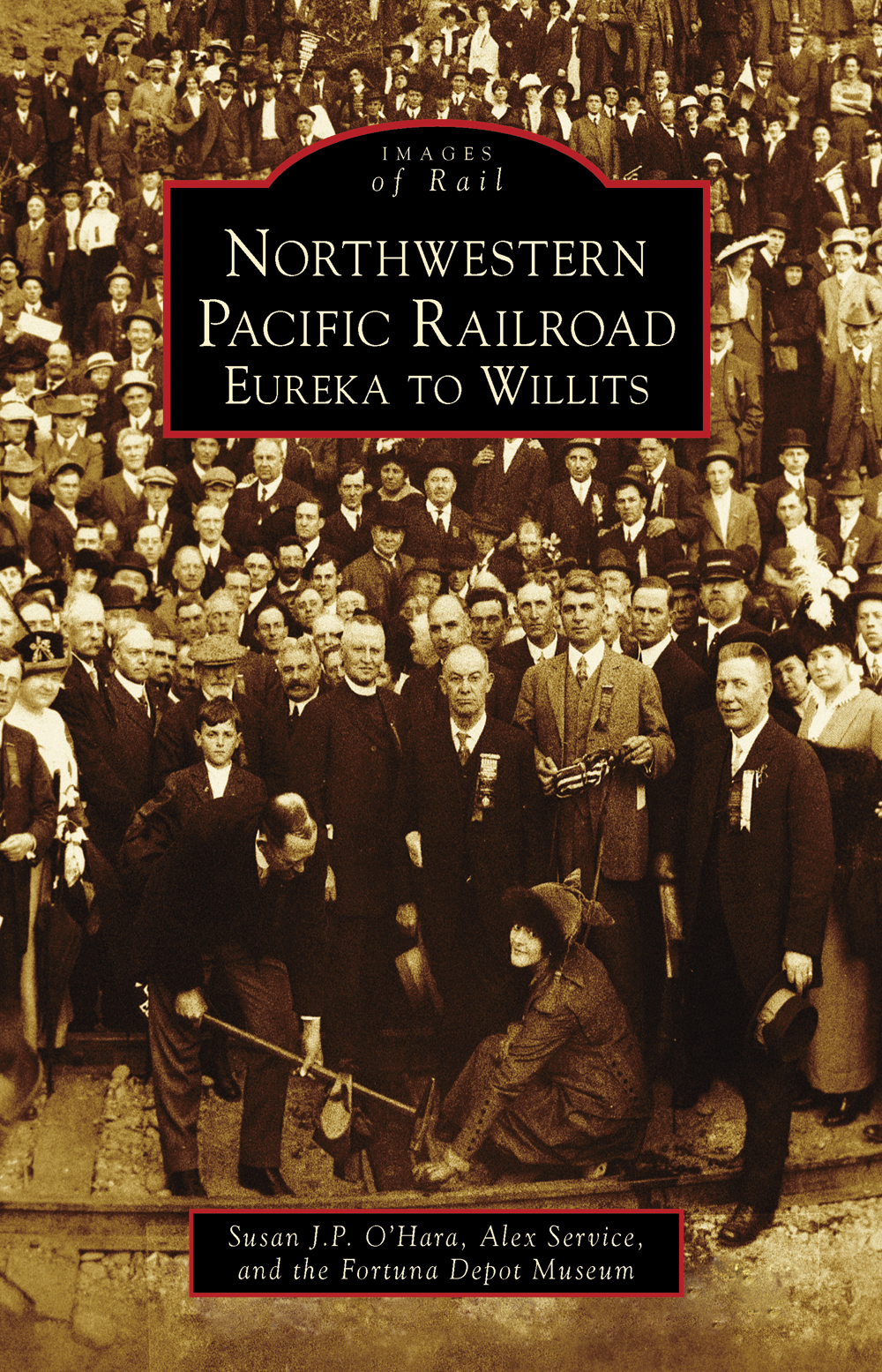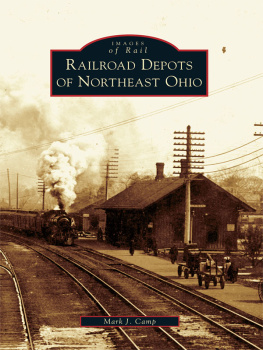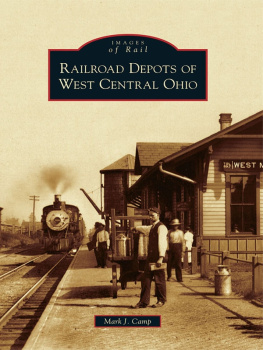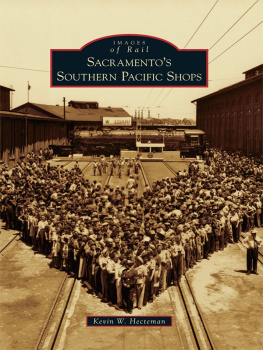
IMAGES
of Rail
NORTHWESTERN
PACIFIC RAILROAD
EUREKA TO WILLITS

In 1908, the united company of the Northwestern Pacific Railroadcreated by the Atchison, Topeka & Santa Fe Railroad and the Southern Pacific Railroadbegan construction to connect Eureka with the San Francisco Bay Area. Although it was yet to be completed, the 100-mile section through remote southern Humboldt and northern Mendocino Counties is shown on this map. (Courtesy of the Fortuna Depot Museum.)
ON THE COVER: On October 23, 1914, crowds gathered at remote Cain Rock to witness a golden spike being driven into a redwood railroad tie to mark the completion of construction of the Northwestern Pacific Railroad (NWP). The crews building south from Eureka and those building north from Willits met at Cain Rock, which is south of Alderpoint along the main fork of the Eel River and still remains inaccessible by car. (Courtesy of Humboldt State University Library.)
IMAGES
of Rail
NORTHWESTERN
PACIFIC RAILROAD
EUREKA TO WILLITS
Susan J.P. OHara, Alex Service,
and the Fortuna Depot Museum

Copyright 2013 by Susan J.P. OHara, Alex Service, and the Fortuna Depot Museum
ISBN 978-1-4671-3062-2
Ebook ISBN 9781439644317
Published by Arcadia Publishing
Charleston, South Carolina
Library of Congress Control Number: 2013935602
For all general information, please contact Arcadia Publishing:
Telephone 843-853-2070
Fax 843-853-0044
E-mail
For customer service and orders:
Toll-Free 1-888-313-2665
Visit us on the Internet at www.arcadiapublishing.com
The authors dedicate this book to their mothers, Margaret Pritchard and Pam Service. They shared the excitement of researching, instilling in their daughters a love of history.
CONTENTS
ACKNOWLEDGMENTS
The authors would like to thank the Fortuna City Council and the Fortuna Historical Commission for their ongoing support of the Fortuna Depot Museum.
Many images in this book are from the collections of the Humboldt Room, Humboldt State University Library (HSU); the Northwestern Pacific Railroad Historical Society (NWPRRHS); and the Humboldt Redwoods Interpretive Association (HRIA). Unless otherwise noted, all images in the book are from the Fortuna Depot Museum.
The Fortuna Depot Museum is enriched by the photograph collections of many people who worked for the NWP and many who dedicated themselves to preserving local history. We wish to thank these individuals and their families for creating this photographic record and saving it for future generations. Collections at the Fortuna Depot Museum, which made this book possible, include those of P.E. Bandy, Ray Barkhurst, Bill Bish, L.E. DuBose, Fred Elliott, Joe Lockhart, Marguerita Nichols, Neil Paulson, Guy B. Rhodes, Evelyn Kruse Swanson, and Francee White. We apologize for any omissions in this list and want to thank those who devoted their lives to the railroad and who have preserved its history.
INTRODUCTION
In Northwest California lie Humboldt and Mendocino Counties. The region, with its steep terrain and large redwood forests, remained isolated from the rest of California until the completion of the Northwestern Pacific Railroad (NWP) in 1914. After being settled by immigrants in the 1850s, the coastal regions of both counties were easily accessed by sea, although the overland route was slow and difficult to traverse. The ocean route was dangerous, too; many ships wrecked along the rugged coastline. Moreover, steam-powered ships took several days to reach San Francisco. In Humboldt County, the sandbar across the entrance to Humboldt Bay was very hazardous. Ships often could not enter the bay or were wrecked due to violent, erratic waves.
In addition to communication and travel, shipping was critical to the economic livelihood of both counties. In the 1850s, the usefulness of redwood lumber, often referred to as red gold, was brought to light. Mills sprang up near the towns of Mendocino, Fort Bragg, Eureka, and Arcata. Mills, a common sight along the coast, were supplied by loggers working in the nearby, seemingly endless forests. However, mill owners were only compensated when they got their products to markets in the San Francisco Bay Area or elsewhere. Sailing vessels utilized small doghole ports to ship lumber along the Mendocino coast. Ports were located at Rockport, Westport, Caspar, Mendocino, and other mill sites. Humboldt County utilized the large bay near Eureka for shipping. The Humboldt Bay entrance was improved by the construction of jetties in the 1880s, and ships were locally built with a shallow draftespecially at Bendixsons shipyard near Samoato cross the sandbar. While this meant more lumber could be taken south, it also meant that each load was limited by the size of the smaller ships.
Railroads, under construction in both counties, were initially used to bring logs to mills around larger communities. The Union Wharf and Plank Walk Company built the first railroad in Humboldt County on the Arcata wharf in the 1850s. The wharf stretched two miles out into the bay, where the water was deep enough for vessels to navigate. A white horse called Spanking Fury served as the locomotive for this rail system in the early years and remained in service until the 1870s.
Other rail lines, either regular or narrow gauge, built in both counties were used to access remote forests after lumber companies harvested the trees closest to communities. As each stand of trees was depleted, the companies would extend the railroads. Large lumber companies operated their own engines and cars and had employees devoted to operating their rail systems. These lines were not built to a high degree of engineering, and they frequently had accidents. The lines also needed large bridges to span ravines and creeks. Since these bridges were made of redwood, they burned easily; the workers at the Caspar Mill frequently found themselves fighting fires and replacing bridges as their locomotive, the Daisy, a 0-4-2 engine, had a tendency to set her bridges aflame. The Caspar Lumber Company was one of many mills along the Mendocino coast with its own logging trains.
In 1884, two important Humboldt mill owners, William Carson and John Vance, joined forces to begin a railroad they hoped would eventually connect Eureka with the outside world. Dubbed the Eel River & Eureka Railroad (ER&ERR), the line linked Eureka to the new railroad town of Alton. The ER&ERR was used for passenger transportation and to haul logs, lumber, livestock, and agricultural produce. Residents of Fortuna and Rohnerville used the line to travel to the county seat of Eureka. The Pacific Lumber Company (T.P.L. Co.), incorporated in 1869, soon extended the line to its company town of Scotia and signed a contract with the ER&ERR to haul lumber to its shipping port at Fields Landing. Other mills in the region, including the Dodge Lumber Company, also extended logging railroads to connect with the new ER&ERR line.
In the early 20th century, the small logging railroads of Humboldt County captured the attention of the Southern Pacific and the Atchison, Topeka & Santa Fe (Santa Fe) Railroads. In 1904, the Santa Fe purchased the ER&ERR, running it as the San Francisco & Northwestern. Vance had extended the line north to Arcata, connecting it with the Arcata & Mad River Railroad. The conglomerates also worked to acquire port space around Humboldt Bay, and both large railroads began making plans to extend railroad lines south to San Francisco.
Next page









